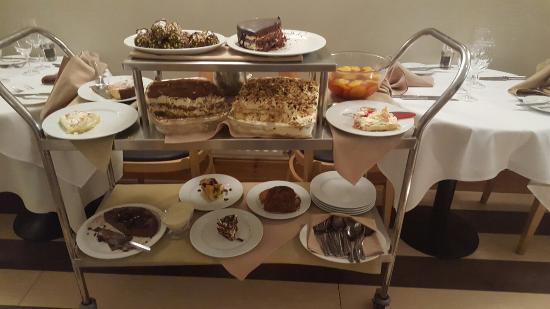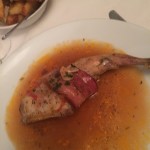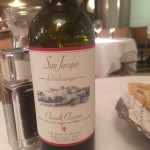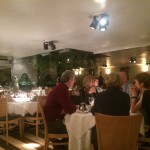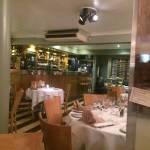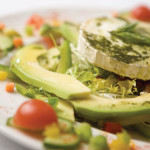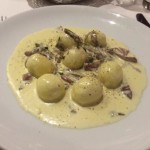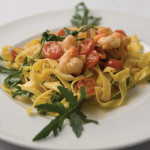The thing we love about Italian restaurants, by which I don’t mean chains but the independent family-run eateries, is that they are abidingly and charmingly old-fashioned in a sense that reminds us of the days when you knew what you would get on your plate but the service harked back to a long-gone era.
Granted the decor at many such restaurants is twee, though they are typically comfortable and by the long experience of waiting and kitchen alike provide a comfort dining experience of the kind we yearn for by comparison with the edgy and experimental dining rooms to be found everywhere these days.
Villa d’Este in Marlow is just such a knowingly old-fashioned Italian restaurant, and none the worse for that, quaint and bijou grotto to mimic an Italian villa and all. On this Thursday evening we wandered in from the street and had plenty of tables to choose from, though presumably the 60 or so covers are filled out on Fridays and Saturdays. Marlow is awash with decent Italian restaurants, all of which presumably offer a good dining experience, presumably because they appreciate comfort dining.
“We take a lot of pride in customer care” says the Villa’s website, and it shows. It’s the little touches that count, like the manager being able to quote a wide range of special starters and main courses in his authentic Italian accent – and the waiter speaking to him in Italian. It’s that last bastion of last century dining, the dessert trolley – and where else do you see one of those nowadays?
Perhaps most of all it’s the sense of warm tranquility and lack of pressure to eat up and get out, thus allowing you and your party to enjoy the company and relax, which, after all, is why we dine out in the first place. A table near us was occupied by a party who ate nothing in the whole time we were there, but were evidently enjoying discussion over coffee and liqueurs – and will return there for more very soon. It’s the repeat business you want when you run a restaurant, and that’s a better way to get it than endless promotions, as found in the chain business.
Starting with the wine list, it was welcome to see a well-chosen and varied selection, including a few half bottles that had not been dredged up from the sewers. The Chianti Classico San Jacopo we sampled surprised and delighted with its very classical and well-structured Sangiovese cherry and ripe fruit flavours. The fact that iced tap water was repeatedly brought on demand also helped.
The menu at Vd’E is elegant, being a class or two above the rustic trattoria and pizzeria, but a touch over-long. It is also sensibly priced, a touch below Marlow standards, such that £70 for two including wine spelled out fine value. It also wins kudos for fresh ingredients, homemade pastas and seasonal specials, including the excellent asparagus gratin with which we started. What a welcome treat to find properly-cooked al dente asparagus as Spring approaches, helped by a sympathetic grilling with vintage Parmigiana Reggiani.
For mains we went for two very Italian meats, one from the specials menu. Her porchetta, redolent of aromatic fennel, rosemary and garlic was sublime (they thoughtfully provide the recipe too – see here.) Its sauce from the cooking juices was sympathetic yet fizzing with character, most definitely an authentic dish. Talking of authentic, my choice of rabbit is described thus on the menu:
Coniglio Alla Villa D’Este – £12.50. Reared Rabbit With Smoked Belly Pork, Wine, Rosemary, Tomato & Chilli
Rabbit is a classic game meat found on the hills in rural Italy, but often ignored in rural Britain. Granted this is farmed rabbit, minus the gamey leanness of wild meat, but the leg served was flavourful and well served by a thin rasher of gently smoky pork and the hit of sauce. Both were accompanied by a rather above average selection of veg (I don’t typically go for the humdrum mixed veg option), plus some rather excellent roast potatoes with onions and rosemary.
We ventured one shared dessert from said trolley; a slice of amaretto gateau with cream seemed apt, given that traditional Italian dining eschews the modern health-conscious fatless diet and instead goes for flavour and ample proportions (this applies equally to the butter, cream and other fats elsewhere in the meal.)
This exemplifies the conundrum with which I started this review: comfort food is in, and authentic Italian comfort food appeals to our consciousness – even if it stands in the face of the health nazis. Remembering the best of our childhoods is no bad thing, yet the Italians seem to do it better than we do. Perhaps if you remember Vesta curries, canned pies and stodgy jam roly-polies that might not be such a bad thing, but as for Villa d’Este I hope they carry on providing the same delicious comfort food like mama used to make for very many years to come.
Restaurants do not need to change and be up to the minute in the fashion stakes to be good, whatever the critics and chefs might tell you. They do need to love and cherish great ingredients, simple recipes and fine service.

